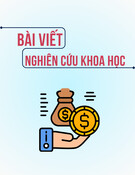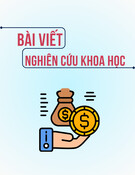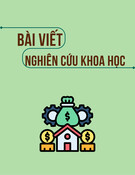
International J
ournal of Business, Economics and Law, Vol. 1
ISSN 2289-1552
2012
Page 48
DETERMINANTS OF DIVIDEND POLICY: THE CASE OF VIETNAM
Nguyen Thi Xuan Trang
Accounting Department
Da Nang University of Economics
71 Ngu Hanh Son Street, Ngu Hanh Son District, Da Nang City, Vietnam
Email: trangatax@gmail.com , Tel: (+84) 0 914 745 649
ABSTRACT
There were several researchers who investigated dividend policy in developed countries like the USA (Chang and Rhee, 1990),
the UK (Al-Najjar and Hussainey, 2009), Argentina (Bebczuk, 2005), Poland (Kowalewski et al., 2008) or Japan (Ho, 2003) and
some authors studying this in developing countries such as Tunisia (Naceur et al., 2006) or Pakistan (Mehar, 2002) with widely
different results but no researches have been done in Viet Nam about the determinants of its dividend policy. Therefore the
purpose of this paper is to examine the determinants of dividend policy in Viet Nam, an emerging stock market that was officially
established in July, 2000. The paper identifies whether firms’ characteristics and corporate governance affect their dividend
payments. Firms’ characteristics include profitability, firm size, debt level, liquidity, asset structure, industry type, growth
opportunities plus business risk; corporate governance comprises management ownership, ownership concentration, board of
directors along with audit quality. The author relies on a sample of 116 companies listed on the Hochiminh Stock Exchange
(HOSE) and Hanoi Stock Exchange (HNX) for the year of 2009 in Viet Nam. Being similar to studies in the US, the UK,
Argentina, Tunisia and Poland, it is found that, in Vietnam, profitability influences positively and business risk impacts
negatively on dividend disbursement. Moreover, there are relationships between industry type as well as audit quality and
dividend payments. This research contributes to Vietnamese literature in asserting that profitability is the most important
determinant of dividend policy in Vietnam, so external investors can rely on expectations about the profitability of a firm in the
future to consider whether they should buy, hold or sell its shares.
Keywords: Dividend policy, Viet Nam, characteristic, corporate governance
INTRODUCTION
Dividend payment is the distribution of net profit after tax to a company’s shareholders after keeping a specific amount of
earnings to reinvest in the business. Dividend policy is a significant concern of both financial managers in shareholding firms
and outside investors. Specially, in Viet Nam, securities are still fresh to investors and people alike; and this can cause confusion
when choosing whether to make buy, hold or sell decisions about stocks. Thus, findings which show how Vietnamese firms’
features and corporate governance affect dividend policy will be of real importance to external investors interested in stock
market investment in Vietnam.
The role and the application of dividend policy are supported by different theories such as signaling theory, trade-off theory,
agency theory, transaction cost theory and pecking order theory. Until now, several researchers have continued to prove and
developed these theories in order to determine the factors which influence the dividend policy of a joint-stock enterprise.
Generally, there are two main groups of factors comprising firm’s characteristics and corporate governance. Firm’s
characteristics include several factors such as profitability (Lintner, 1956; Fama and French, 2002), firm size (Farinha, 2003;
Bebczuk, 2005), debt level (Chang and Rhee, 1990; Belden et al., 2005), liquidity (Ho, 2003; Myers and Bacon, 2004), asset
structure (Myers, 1984; Koch and Shenoy, 1999), industry type (Baker and Powell, 2000; Naceur et al., 2006), growth
opportunities (Kowalewski et al., 2008; Al-Najjar and Hussainey, 2009) and business risk (Aivazain et al., 2003; Li and Zhao,
2008). Corporate governance consists of management ownership (Jensen et al., 1992; Short et al., 2002), ownership
concentration (Khan, 2006), board of directors (Bathala and Rao, 1995) and audit quality (Deshmukh, 2005). It is found that
factors impacting dividend policy are still the subject of debate.
The above fact provides the reason for this research's examination of the determinants of dividend policy in Viet Nam, a
developing country with the emerging stock market in Asia.
LITERATURE REVIEW AND RESEARCH HYPOTHESES
DIVIDEND POLICY AND FIRM CHARACTERISTICS
a. Dividend policy and profitability
Lintner (1956) found that the most important factor influencing dividend decisions is the association between present earnings
and the dividend rate. A few years later, Jensen et al. (1992) also asserted a positive link between dividends and current
profitability that can be measured by the ratio of operating income to total assets. Fama and French (2002) suggested that this
relationship happens in order to mitigate the agency problem as enterprises with higher profits have more free cash flows;
additionally, more profitable firms can still pay greater dividends without financing investments with risky debt and equity in
accordance with the pecking order model.
Most authors proved a positive association between profitability and the payment of dividends in different countries such as
America, Argentina or Tunisia. Therefore, this same directional relationship will be checked for Vietnam to consider whether
dividend policies in Vietnamese companies are also affected positively by their profitability like other countries or not. From that
the first hypothesis in this study is that

International J
ournal of Business, Economics and Law, Vol. 1
ISSN 2289-1552
2012
Page 49
H1: There is a positive association between profitability and the dividend expenses of firms on the HOSE and HNX.
b. Dividend policy and firm size
Myers and Majluf (1984) found that the asymmetric information situation between managers and external investors leads to
underinvestment problems. Based on that, Deshmukh (2003) clarified this with respect to the change in the dividend. When other
things are constant, the higher the level of asymmetric information that can be shown due to the smaller firm size, the higher
probability of underinvestment; so the lower the dividends paid to stockholders. However, Naceur et al’s (2006) results, based on
48 listed companies on the Tunisian Stock Exchange between 1996 and 2002, showed that smaller corporations want to disburse
more dividends as they can catch the attention of potential investors to lessen their inherent risks.
Thus, there seems to be a relationship between firm size and dividend yield but there are still arguments about the direction of
this association. In case of Vietnam, this study tests whether firm size influences dividend yield of privatized companies or not.
The following hypothesis is set:
H2. There is an association between firm size and the dividend payments of firms on the HOSE and HNX.
c. Dividend policy and debt level
Debt level measures the level at which a corporation relies on external funds to finance investments (Al-Najjar and Hussainey,
2009). A correlation between debt level and dividend disbursement is expected from the trade-off theory and pecking order
theory. Several authors examined this relationship but until now there are competing ideas. Chang and Rhee (1990) supported a
positive association because they argued that higher financial leverage exists in relation to lower shareholder tax rates, so it
makes the firm willing to pay higher dividends. Belden et al. (2005) also found, when they test 524 large American firms in the
list of Forbes 500 from 1998 to 2000, that debts are still used in companies applying dividend policy to control agency problems.
On the other hand, the view of Jensen et al. (1992) was different in that they believed financing from equity is more attractive to
firms having high dividend ratios than from debt, so low ratios of long-term debt to the book value of total assets often happen in
these companies. Bebczuk (2005) and Kowalewski et al. (2008) agreed with the idea of Jensen et al. (1992) in that they thought
that firms with high leverage seem not to want to reimburse high dividends and get more loans with the purpose of limiting
default risk. Neutrally, Al-Najjar and Hussainey (2009) suggested there is no relation between these two factors because of the
statistically insignificant results of hypothesis tests. Naceur et al.’s (2006) results showed that the total debt to the equity’s
market value does not affect the dividend yield.
Because there is no consensus about the relationship between dividends and debt level, this study will test whether this
association exists in the Vietnamese joint-stock enterprises or not. Hence, another hypothesis related to debt level is suggested:
H3. There is a link between dividend disbursement and the debt level of enterprises on the HOSE and HNX.
d. Dividend policy and liquidity
Liquidity is the extent at which a firm can pay short-term liabilities based on its liquid assets (Atrill and McLaney, 2002). Ho
(2003) found that the more liquid firms in Japan have higher dividend payouts. Mehar (2002), however, suggested there is an
inverse relationship between liquidity position and dividend payments from his study of companies on the Karachi Stock
Exchange in Pakistan as firms with positive working capital will lower dividends. Myers and Bacon (2004) highlighted that
corporations are likely to lessen dividends to spread liquidity. However, a few years later, Al-Najjar and Hussainey (2009)
proved that paying lower or higher dividends does not depend on a good or bad liquidity position.
Since there is still a debate about this association, this study will test whether the dividend policy of companies in Vietnam is
impacted by liquidity. From that the next hypothesis is proposed:
H4: There is a relationship between the liquidity and the dividend policy of the businesses on the HOSE and HNX.
e. Dividend policy and asset structure
Myers (1984) assumed that companies owning the most tangible assets are likely to borrow more than those owning the most
intangible assets, so they have the ability to keep less retained earnings and pay higher dividends according to pecking order
theory. Therefore, a positive relationship between the tangible assets ratio and dividend payments is expected. Nevertheless,
Aivazian et al.’s (2003a) results showed that an inverse association between tangibility of assets and dividend policy exists in
listed firms in some emerging markets. The view of Al-Najjar and Hussainey (2009) was similar in that they believed that the
more tangibility the more dependence on retained earnings because of lower financing from debts, so the lesser dividends are
paid towards shareholders.
Since there are opposite results from authors applying different arguments, this research will attempt to determine whether there
is an influence of asset structure on the dividend payments of Vietnamese shareholding firms. Thus, the following hypothesis is
put forward:
H4: A relationship between asset structure and dividends subsists of firms on the HOSE and HNX.
f. Dividend policy and industry type
Baker et al. (1985) proposed that various types of firms have different dividend policies. After that, Baker and Powell (2000)
divided U.S. companies listed on the NYSE in 1997 into three industry groups involving utility, that belongs to a regulated
industry, manufacturing and wholesale/retail trade, that are less regulated industries. They discovered that utilities reimburse
higher dividends than firms in the manufacturing and wholesale/retail trade, because shareholders desire current income rather
than future income and managers prefer less risk in regulated industries. In Vietnam, companies listed on the two Stock
Exchanges are classified into ten groups consisting of Consumer Goods, Public Services, “Agriculture, Forestry, Fisheries”, Raw
Materials, “Health and Social Support Activities”, Finance, Diversified areas, Industry, Consumer Services and Technology.
Therefore, this study will test whether there is a difference among these ten types in paying dividends, so the following
hypothesis is set up:

International J
ournal of Business, Economics and Law, Vol. 1
ISSN 2289-1552
2012
Page 50
H5: A connection between industry type and dividend policy of companies on the HOSE and HNX is anticipated.
g. Dividend policy and growth opportunities
Myers and Majluf (1984) discovered that increasing the growth opportunities of the corporation raises the ex ante
underinvestment that leads to less dividends paid to shareholders. Chang and Rhee (1990) also highlighted that firms having
greater opportunities for growth prefer retaining earnings to finance the development than paying dividends, so the higher the
growth opportunities, the lower the dividend payments. Nevertheless, some researchers’ results show an irrelevant link between
these two variables. For example, Naceur et al. (2006) indicated that the market value of equity to book value of equity ratio, that
is a proxy of investment opportunities, does not impact on dividend reimbursement in Tunisia. Additionally, Kowalewski et al.
(2008) found a statistically insignificant result in the effect of Tobin's q variable that represents investment prospects on
dividends in Poland. For this reason, this study will examine whether this correlation subsists in the Vietnamese stock market.
The next hypothesis is offered:
H6: There is an association between growth opportunities of a firm and its dividend policy on the HOSE or HNX.
h. Dividend policy and business risk
Al-Najjar and Hussainey (2009) defined business risk as the probability of decrease in returns on investment owing to
exceptional circumstances. Under transaction cost theory, Rozeff (1982) suggested that the transaction costs of external financing
will be higher when the firm has higher operating and financial leverage or more risks that can be measured through the greater
beta coefficient. This is compatible with Holder et al. (1998) who highlighted that riskier firms suffer larger transaction costs.
Thus, a lower dividend policy seems to be applied to riskier companies in order to lessen the transaction expenses from outside
finance. Additionally, Chang and Rhee (1990) suggested the reason for this negative relationship is that a firm with lower risk or
more stability of earnings has more capacity for remaining or paying more dividends in the future. Aivazain et al. (2003), Li and
Zhao (2008) agreed with the suggestion of Chang and Rhee’s (1990) in that they thought that the lower the business risk the
greater the dividends shelled out. Because most authors proposed the contrary impact of risk on dividend policy of a firm, this
negative relationship will be tested on joint-stock firms in Vietnam. Therefore, the following hypothesis is suggested:
H7. There is an opposite correlation between business risk and dividend disbursement of enterprises on the HOSE and HNX.
DIVIDEND POLICY AND CORPORATE GOVERNANCE
a. Dividend policy and ownership
Jensen et al (1992) and Short et al. (2002) proved that the payment of dividends is in inverse direction to insider ownership for
the reason that it is not necessary to pay high dividends to lessen agency costs at the same time when the management ownership
is high. However, according to Farinha (2003), this contrary association is only appropriate before a critical entrenchment level;
after that level, the ownership and dividends will compensate each other.
Ownership can be represented not only by the management ownership but also by the ownership concentration of shareholding
blocks, as in the study of Khan (2006). Whereas Khan (2006) discovered the higher the concentrated ownership the lower
dividend payments, when he tested 330 UK companies from 1985 to 1997; Naceur et al. (2006) found that the concentration of
ownership does not affect dividend policy in Tunisia because increasing dividends is not encouraged as agency conflicts of
Tunisian corporations are not so high.
Due to mixed results from prior researches relating to the impact of ownership that can be measured by management ownership
or ownership concentration on dividend policy, this research will check whether these two aspects of ownership influence
dividends in the case of Vietnam. Hence, the two next hypotheses are proposed as follows:
H8: There is a relationship between dividend policy and management ownership of firms on the HOSE and HNX.
H9: An association between dividend payments and ownership concentration exists for businesses on the HOSE and HNX.
b. Dividend policy and board of directors
Dividend payments and board composition are means to limit agency disputes, as mentioned in study of Bathala and Rao (1995).
Most researchers measure the board composition by the ratio of outside directors to total directors. In the study of Belden et al.
(2005) in the U.S., they found that the more outsiders in the board the more dividends are paid to lower agency costs and the
more freedom there is for shareholders in spending their money. On the other hand, Bathala and Rao (1995) as well as Al-Najjar
and Hussainey (2009) supported the negative relation between these two factors as they argued that dividend disbursement and
independent directors are substitutive mechanisms to reduce interest conflicts between principals and agents. Although
Schellenger et al.’s (1989) findings were not consistent with that judgment, they asserted that the board composition does impact
on dividend policy.
From the different judgments of authors on the relationship between board composition and dividend policy and the unique
characteristics of shareholding companies in Vietnam, the following hypothesis is expected:
H10: Board composition does affect the dividend payments in this country
c. Dividend policy and audit quality
Deshmukh (2003) stated that when other things are constant, the higher the level of asymmetric information that can be shown
through low audit quality of financial reports, the lower the dividends paid to stockholders. This is because of underinvestment
according to pecking order theory. Results in Deshmukh’s (2005) research of American manufacturing companies from 1988 to
1992 also showed agreement with the pecking order theory. He stated that asymmetric information levels will become higher

International J
ournal of Business, Economics and Law, Vol. 1
ISSN 2289-1552
2012
Page 51
when the number of analysts for a company is low, so dividend expense is not encouraged to restrain the problem of
underinvestment. In addition, Mitton (2004) found that firms that are audited by the Big five accounting firms seem to pay more
dividends to shareholders. Furthermore, Allen et al. (2000) proposed that dividend payment is a signal of a firm’s quality. The
firm that increases dividends to shareholders often wants to prove its high quality.
Because most writers support the positive relationship between audit quality and dividend policy, the last hypothesis suggested in
this study is that:
H11: Audit quality affects dividend policy of an enterprise listed on the HOSE or HNX positively.
RESEARCH DESIGN
DATA
On July 06th 2010, there were 251 shareholding companies on HOSE and 308 on HNX1. This study focuses on researching the
determinants of the dividend policy of the listed companies on HOSE and HNX in Vietnam in 2009. Therefore, firms having
base date from 2009 onwards or no dividends declaration since they were listed are rejected. After that, the author continues to
eliminate shareholding corporations that did not publish sufficient annual reports for 2008 and 2009 or did not provide detailed
information about shareholders in their annual reports for 2008 or did not have obvious dividend policies in 2009. The final
number of research sample is 116 companies, including 63 firms from HOSE and 53 companies from HNX.
There are twelve variables expected to have a relationship with dividend disbursement in Vietnam and these can be divided into
two groups.
Firm characteristics group contains profitability, firm size, debt level, liquidity, asset
structure, industry type, growth opportunities and business risk.
Corporate governance group involves management ownership, ownership concentration,
board of directors and audit quality variables.
These variables together with dividend payment can be defined and measured as follows:
- Dividend payment:
Dividend payment shows the amount of dividends shareholders receive based on the number of shares they keep during a period.
Dividend per share is used to measure dividend payment in Vietnam in this study because, as Naceur et al. (2006) argued, the
usage of per share data can help to counteract the effects of any variation in the quantity or structure of capital. The information
about dividend per share of each listed Vietnamese company is collected from Datastream.
- Profitability
This research uses return of total assets (ROA) to measure profitability. This data is collected from 2009 financial statements of
listed firms on HOSE and HNX
- Firm size
This study follows the popular approach of several authors such as Mitton (2004), Bebczuk (2005) and Kowalewski et al. (2006)
in applying a logarithm of assets as a proxy of firm size. The total assets are gathered from 2009 financial reports of shareholding
companies in Vietnam.
- Debt level
Debt level can be determined by the total debt to total assets ratio. The information about total debt and total assets in 2009 is
collected from the balance sheets of businesses on HOSE and HNX.
- Liquidity
This study follows the approach of Myers and Bacon (2004) in using the current ratio, being defined as a proportion between
current assets and current liabilities, as a proxy of liquidity. 2009 financial statements of Vietnamese corporations on HOSE and
HNX are sources from which to gather information on current assets along with current liabilities.
- Asset structure
Asset structure reflects the level of tangibility of a company. Koch and Shenoy (1999), Al-Najjar and Hussainey (2009) utilized
the ratio of fixed assets to total assets to evaluate tangibility. This research also applies this measurement and is based on data
collected from the 2009 financial reports of firms listed on the HOSE and HNX.
- Industry type
This paper will filter listed enterprises in which The State holds more than 50 percent of stocks among 116 companies in the
sample and consider them as regulated firms, otherwise they are unregulated corporations. A dummy variable (INTdum) of 1 is
exploited to represent a regulated firm, or else it is 0. The proportion of shares the State owns in each firm is collected from
BIDV Securities Company (BIDV Securities Company, 2010).
- Growth opportunities
This research’s approach to future growth is identical to that of Naceur et al. (2006) in choosing the ratio of market value of
equity to book value of equity to measure investment opportunities. The information about book values of equity is gathered
1 Source: http://www.bsc.com.vn/Industries.aspx

International J
ournal of Business, Economics and Law, Vol. 1
ISSN 2289-1552
2012
Page 52
from balance sheets in 2009 of companies on HOSE and HNX, while market value of equity of each of the listed firms is
collected from Datastream.
- Business risk
This study agrees with the approach of Rozeff (1982), Ho (2003) and Al-Najjar and Hussainey (2009) in utilizing Beta to
represent risk. The data on each firm on HOSE and HNX can be gathered directly from Vietstock Company (Vietstock
Company, 2010).
- Management ownership
Short et al. (2002) defined management ownership as the proportion of equity that directors and their close relations owned at the
beginning of the accounting period. This paper relies on Short et al. (2002)’s definition to collect the percentage of equity being
owed by directors and their close relations early in the year of 2009 from the annual report of 2008 of listed companies on HOSE
and HNX.
- Ownership concentration
Ownership concentration is defined as the quantity of large shareholders holding greater or equal to 5% of stocks at the start of
2009 that is gathered from 2008 annual reports of listed firms in Vietnam.
- Board compostion
The ratio of independent non-executive directors to total directors at the beginning of the year 2009 is applied to represent
structure of directors’ board in this study. This data is hand gathered from 2008 annual reports of sample companies on the
HOSE and HNX.
- Audit quality
Audit size stands for audit quality in this research. The audit size will be coded as 1 if the joint-stock company on the HOSE or
HNX was audited by one of the ten biggest audit companies according to the ranking of VACPA, otherwise it will be coded as 0
(figure 1).
31,805.00
37,200.00
39,113.00
62,134.00
77,384.00
89,616.00
266,324.00
273,130.41
323,089.00
333,669.00
BDO Vietnam Co. Ltd (BDO)
Mazars Vietnam Co. Ltd (Mazars)
Auditing and Informatic Services Co. Ltd (AISC)
Grant Thornton Vietnam Limited (G.T)
Auditing & Accounting Financial Consultancy Service Co. Ltd (AASC)
Auditing and Consulting Co. Ltd (A&C)
Deloitte Vietnam Co. Ltd (Deloitte)
Price Waterhouse Cooper Vietnam Limited (PwC)
Emst & Young Vietnam Limited (E&Y)
KPMG Vietnam Limited (KPMG)
Total revenue (millions dong)
METHODOLOGY
In this study, SPSS software is applied to analyze the collected data. There are 12 independent variables being used in this study.
Among them, ten variables are scale variables (profitability, firm size, debt level, liquidity, asset structure, growth opportunities,
business risk, management ownership, ownership concentration and board composition) and two variables are nominal ones
including industry types and audit quality. Therefore, firstly, ten scale variables are tested in relation to dividend per share by
Pearson Correlation. Secondly, Multiple Regression will be done to build a suitable model for dividend per share in Vietnam
without multicolinearity among influential factors. More specifically, the author will test VIF values and consider preliminary
results of Correlation Analysis through t-tests statistics. Because the Stepwise method of Multiple Regression is considered as a
method being used most frequently (Foster, 1998), it will be used to build up a general equation:
Dividend payment = a + b1 Profitability + b2 Firm size + b3 Debt level + b4 Liquidity + b5 Asset structure + b6 Growth
opportunities + b7 Business risk + b8 Management ownership + b9 Ownership concentration + b10 Board composition (1.1)
Where: - Dividend payment is the dependent variable
- Profitability, firm size, debt level, liquidity, asset structure, growth opportunities, business risk, management
ownership, ownership concentration and board composition are independent variables
- a is the intercept
The anticipated equation can be rewritten after encoding all variables as follows:
DPS = a + b1 ROA + b2 LoA + b3 DtA + b4 Cur + b5 TANGtA + b6 MBV + b7 BETA + b8 MOdum + b9 NuLS + b10
INDtD
















